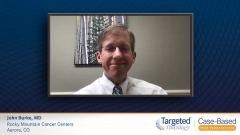
L-Mind Trial and Implications for R/R DLBCL
John Burke, MD, reviews the practical implications and role of tafasitamab and lenalidomide in addition to reviewing significant results from the L-MIND trial.
John Burke, MD: What data do we have to support the use of tafasitamab and lenalidomide, and why did that combination get approved? The trial that supported and was pivotal for that combination was called the L-MIND trial. This was published by Dr Salles [Gilles Salles, MD,] and others in The Lancet Oncology in 2020. Tafasitamab's mechanism of action is that it is an anti-CD19 [B-lymphocyte antigen] monoclonal antibody. It has an engineered Fc portion of the antibody with 2 amino acid substitutions that increase the binding affinity of the antibody to Fc gamma receptors on effector cells, like NK [natural killer] cells and macrophages. Tafasitamab leads to NK cell mediated antibody-dependent cellular cytotoxicity [ADCC], macrophage-mediated antibody-dependent cellular phagocytosis [ADCP], and direct cell death. Those are the mechanisms of tafasitamab being able to kill malignant B-cells. What is the rationale for combining tafasitamab with lenalidomide? Well, lenalidomide stimulates proliferation and activation of NK cells, and by itself can cause direct cell death of lymphoma cells. The thought behind this is that perhaps the activation of NK cells by lenalidomide, combined with the powerful initiation of antibody-dependent cellular cytotoxicity from tafasitamab, would lead to a synergistic combination.
Indeed, in vitro, the combination of tafasitamab plus lenalidomide does increase NK cell-mediated ADCC compared with tafasitamab alone. These factors led to the rationale to combine these 2 agents in patients with relapsed lymphoma. What was the L-MIND trial? Well, this was a phase 2 study. Eligible patients had relapsed refractory DLBCL [diffuse large B-cell lymphoma] and had been treated with between 1 to 3 prior regimens. The study excluded primary refractory DLBCL, which was initially defined as a case that relapsed within 3 months of R-CHOP [rituximab, cyclophosphamide, doxorubicin [hydroxydaunomycin] vincristine (oncovin), prednisone], but subsequently defined as within 6 months of R-CHOP. By the phase 2 design, all patients were treated with the same combination of tafasitamab plus lenalidomide. Lenalidomide was dosed at 25 mg orally on days 1 through 21 of a 28-day cycle.
Tafasitamab was given weekly for the first 3 cycles; these are 4-week cycles. There was an additional loading dose on day 4 of cycle 1. After 3 months, the schedule changed to every other week. After 1 year of combination therapy, the lenalidomide was discontinued and patients continued maintenance tafasitamab—again, every other week—administered intravenously. The primary endpoint of the L-MIND study was overall response rate. Eighty-one patients were enrolled and treated. They had a median age of 72 years, and the median number of prior therapies was 2. About half of the patients had received only 1 prior therapy; it is important to keep that in mind. Because this combination can be used either in the second-line for patients for whom you know will be transplant ineligible, or in the third-line setting and beyond for patients who have relapse after transplant, or, again, in patients who are not transplant eligible. Only 11% of the patients in the study had received prior transplant.
The results reflected that the combination achieved an overall response rate of 59% and a complete response rate of 41%. The median duration of response was very impressive at 35 months, and the median progression-free survival was 16 months. Overall survival was reported as almost 3 years at 32 months. Toxicities of the combination most commonly observed included neutropenia, which was grade 3 or 4 in almost half of patients. Febrile neutropenia occurred in 12% of patients. Thrombocytopenia was also seen, as were rash, diarrhea, and fatigue, much of which may be from the lenalidomide.
The combination is well tolerated, but 18% of patients experienced serious events. Infusion reactions with the antibody are not common, but not unheard of. About 6% of patients had grade 1 infusion reactions. There were no serious infusion reactions. Lenalidomide was reduced—not infrequently, as you can imagine—with 25 mg being the starting dose, although many patients were able to stay on at least 20 mg or higher. That's a summary of the L-MIND trial and the recent approval of tafasitamab and lenalidomide.
Transcript edited for clarity.
Case: A 76-Year-Old Man with R/R DLBCL
Initial presentation
- A 76-year-old man presented with fatigue, loss of appetite
- PMH: atrial fibrillation, hypertension, medically controlled
- PE: palpable 5 cm right inguinal mass; bilateral axillary lymphadenopathy; splenomegaly
- ECOG PS 2
Clinical Workup
- Labs: Hb 9.9 g/dL; all others WNL
- Hepatitis B, C and HIV negative
- Excisional biopsy of the lymph node confirmed DLBCL, GCB subtype
- IHC positive for CD20
- FISH panel: t(14;18) with a BCL2 rearrangement
- Flow cytometry: CD19-postitive
- Whole body PET/CT scan showed diffuse lymphadenopathy , splenomegaly
- Ann Arbor stage III DLBCL
- IPI score intermediate-risk
Treatment
- Treated with R-CHOP x 6 cycles
- First post-treatment PET/CT scan was unremarkable; CR
- 1 year later he presents with recurrent axillary lymphadenopathy
- Repeat biopsy confirms relapse of DLBCL, GCB subtype
- He was ineligible for high-dose chemotherapy and ASCT
- Initiated tafasitamab + lenalidomide







































